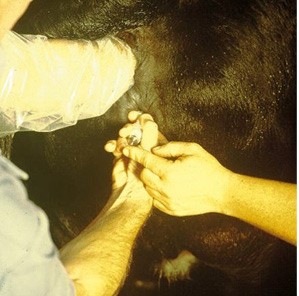
Factors Affecting Pregnancy Rates in Embryo Transfer Programs

A recently published paper reported their results in (Theriogenology, 86 2016 1834-1841) from 516 embryo collections and 10,297 embryo transfers. This work was performed on Holstein cows but the results could be applied to beef cattle. Some of the factors you probably know but some you will not be aware of. In addition the performance of IVF embryos are included and compared to regularly collected embryos. In general cows which had previously produced calves yielded more eggs (as compared to embryos) and a lower percentage of transferable quality embryos (TQE) compared to females that have not produced a calf (see table one).

Comparing recipients, day of transfer, quality, day of collection, temperature and humidity. See tables 2, 3, and 4. There were significant differences based on the day of transfer days 7 and 8 were the optimum days (Table 2), as expected quality of the embryo has a significant affect, once high temperature and high humidity occurred results were significantly lower.



Previous calving problems such as difficult calving and metritis (infected uterus) result in lower pregnancies. To avoid these problems and unnecessary expense I will attempt a single embryo collection prior to going to the expense of superovulation. If an embryo is collected-great-but the real purpose is to observe the uterine debris at the bottom of the search dish. If there is an abnormal amount of cellular material then wait another 3 weeks before attempting superovulation. Any experienced embryo technician will recognize this problem. In addition the act of washing the uterus with media will assist the healing process. It has been recorded that 50 percent of dairy cows suffer from endo-metritis after difficult calving which is often not diagnosed since there is no observable discharge. In this paper pregnancies were compared between fresh, frozen, IVF and IVF frozen embryos. As expected the fresh embryos were the most successful, followed by the IVF then frozen fresh and last were the frozen IVF. See table5.

To summarize, there is very little difference in transferable quality embryos collected between the 3 groups of donors, however those donors who have produced several calves gave significantly more eggs so possibly an extra AI would help, Days 7 and 8 are the best days for flushing donors, obviously embryos classified as number one result in the highest number of pregnancies which is comforting to establish our methods of classification are accurate, avoid when possible periods of very hot and humid weather, as expected there are significant differences between fresh embryos, frozen embryos, IVF embryos and IVF frozen thawed embryos which significantly increases the cost of embryo transfer. There are of course exceptions to the rule in most of these groups of donors and we cannot always select optimum conditions for our work.
Dr. Peter Elsden
Testimonials
"The majority of our insight to embryo transfer is definitely accredited to Dr. Peter Elsden. The pragmatic experiences and personal attention offered through The International Embryo Technology School are highly commendable."… "An example of the benefits to our embryo transfer program, made possible by The International Embryo Technology School, is a cow that produces embryos for only $20 a piece. Each embryo is valued at $1,500 or more! We hold Dr. Peter Elsden and International Embryo Technology School with our highest regard, as they are largely responsible for our accomplishments."
Bob & Robin Stevenson
Stevenson Angus Ranch

|
|
|